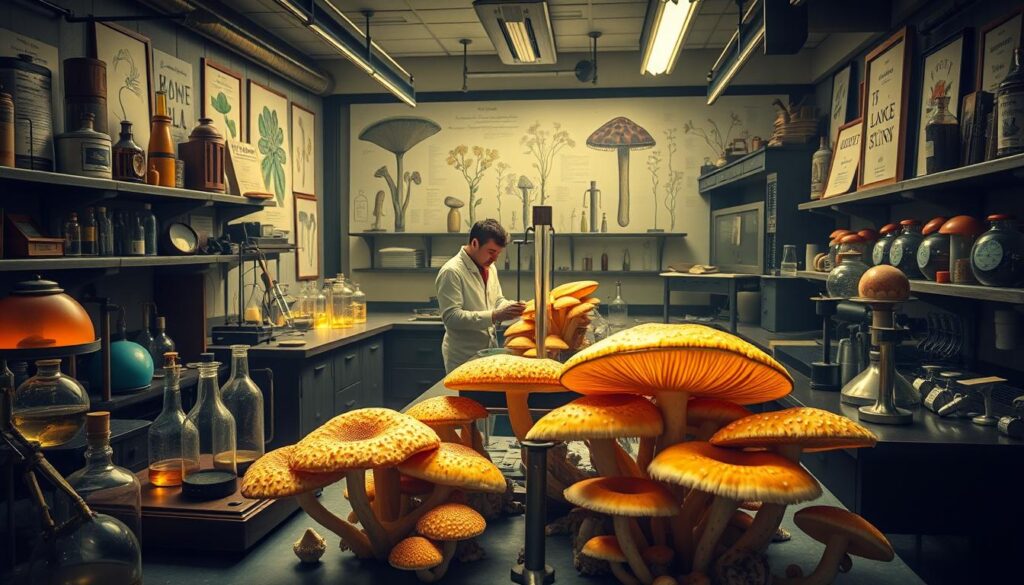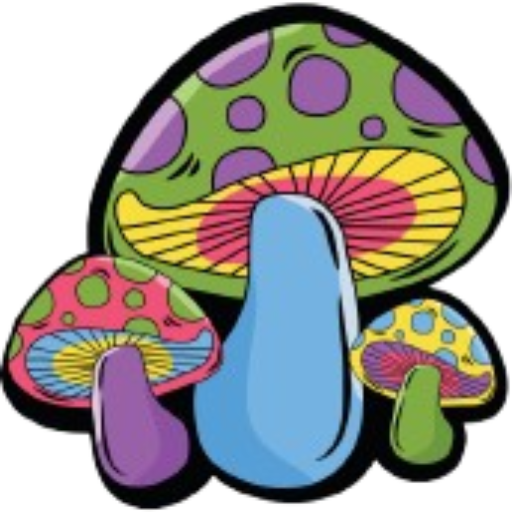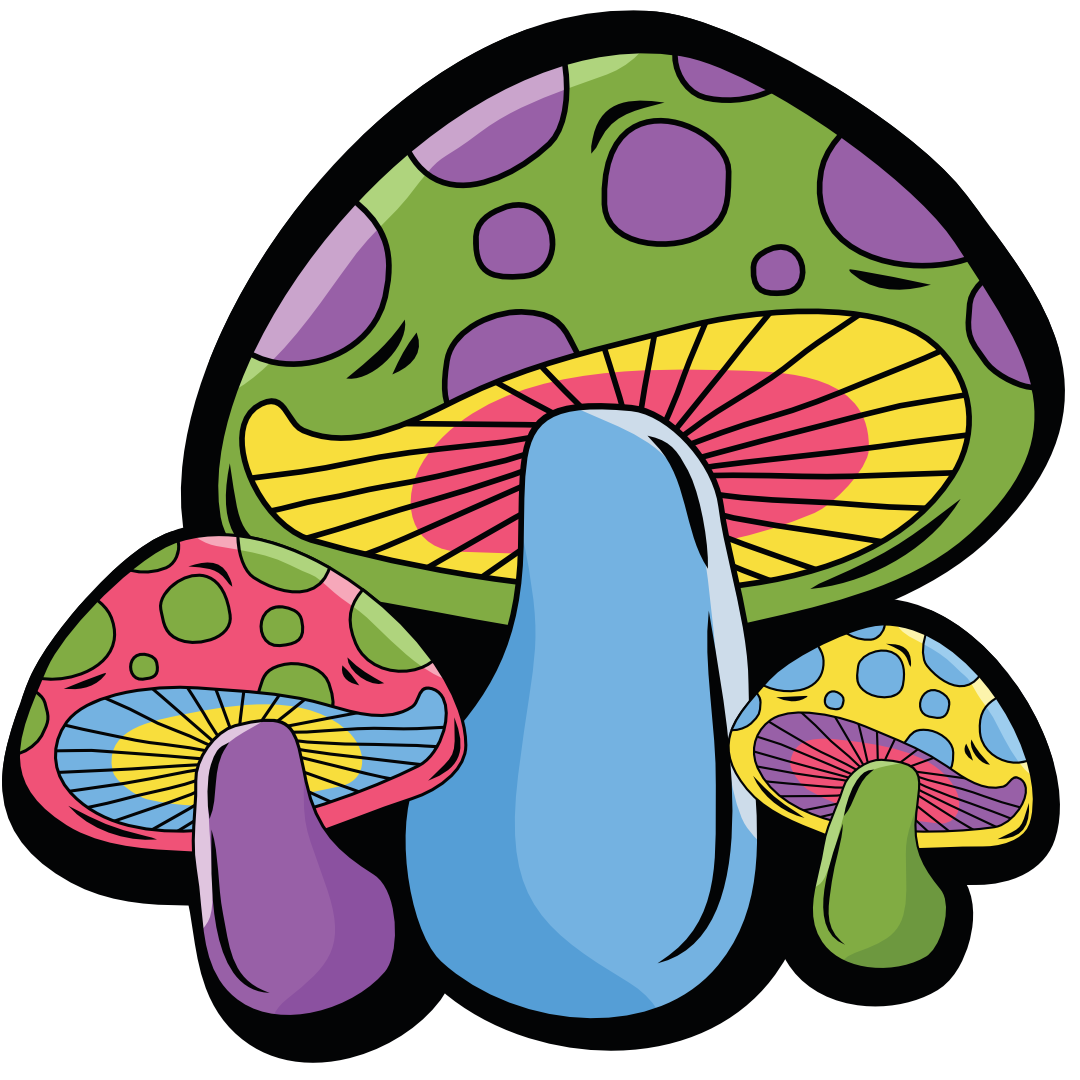The history of psilocybin, found in some mushrooms, goes back thousands of years. It shows up in early human civilizations worldwide. From ancient rock art in Algeria to the Aztecs’ use in Mexico, psilocybin’s story is part of human history.
Archaeologists have found clues about humans and psilocybin mushrooms. Rock art from 9000-7000 BCE in Tassili, Algeria, shows psychedelic effects. Rock art near Villar del Humo in Spain also shows 6,000-year-old rituals with Psilocybe hispanica.
In the 16th century, Spanish missionaries tried to erase the Aztecs’ use of “god’s flesh” mushrooms. But, a Franciscan friar named Bernardino de Sahagún documented their rituals. This gives us a rare look at their historical importance.
Origins of Psilocybin Use
Studies show that indigenous people used psilocybin, a psychedelic found in mushrooms, for thousands of years. Cave paintings in Algeria and Spain suggest our ancestors used it before history was recorded.
Cave Paintings and Rock Art
The Tassili Mushroom Figure, found in Algeria, shows the effects of psilocybin mushrooms. It dates back to the Neolithic period, between 9000-7000 BC. Rock art in Algeria and Spain also points to ancient use of psilocybin in spiritual practices.
Mayan and Aztec Ceremonial Use
In Mesoamerica, psilocybin mushrooms, called Teonanácatl, were used in rituals before the Spanish arrived in the 16th century. Mayan “mushroom stones” in Guatemala prove the ancient use of these mushrooms. They were used to enter altered states and connect with the divine.
“Small-scale societies placed high cultural value on the personal revelations produced by hallucinogenic plants.”
First Written Accounts of Psilocybin Mushrooms
The early written accounts of psilocybin mushrooms give us a peek into their history. After the Aztecs were defeated, the Spanish tried to stop their old ways. This included the use of these special mushrooms in their rituals.
But some Spanish writers, like Diego Durán and Bernardino de Sahagún, kept the truth alive. They wrote about the Aztecs using psilocybin mushrooms in the 16th century. Their stories show how these mushrooms were important to the Indigenous people of Mesoamerica, even when they had to keep it secret.
These early writings tell us a lot about the cultural and spiritual value of psilocybin mushrooms. They help us understand the deep connection between these plants and the Indigenous communities of the Americas.
Indigenous Use of Psilocybin Across the Americas
For centuries, Indigenous communities in the Americas have used psilocybin mushrooms. They call these mushrooms “spirit medicines.” These substances were used in rituals, ceremonies, and daily life. They helped find lost items, talk to nature and ancestors, and keep the community balanced.
Ritual and Healing Practices
Psilocybin use often involved fasting and drumming to enter a trance. It was about the community’s wellbeing, not just mental health. These mushrooms were seen as sacred and used in healing.
Communicating with Nature and Ancestors
Indigenous cultures like the Aztecs and Mayans used psilocybin to connect with nature and ancestors. They believed it helped access higher consciousness and maintain harmony with the environment and their heritage.
Psilocybin mushroom use started in North Africa around 9000 BCE and Spain around 4000 BCE. In the Americas, it dates back at least 3,500 years. The Aztecs used them for divination and healing since the mid-16th century.
The Catholic Church’s actions during the Spanish Colonial period suppressed mushroom use. This hurt the knowledge of psilocybin among the Aztecs and other Indigenous groups. Yet, the use of these sacred substances has continued, with knowledge passed down in some communities.
Western Rediscovery and Research
In 1957, American banker R. Gordon Wasson wrote about his psychedelic experiences with psilocybin mushrooms in Mexico. His article in Life magazine caught the eye of French mycologist Roger Heim. Heim joined Wasson on a trip and found several mushrooms to be Psilocybe species.
Hofmann’s Isolation of Psilocybin
Heim sent samples to Albert Hofmann, a chemist at Sandoz in Switzerland. Hofmann’s team isolated and identified psilocybin and psilocin from Psilocybe mexicana in 1958. This was a big step in psilocybin research history.
Hofmann’s work on psilocybin isolation opened doors for more research. His findings helped show psilocybin‘s potential for therapy. Today, scientists still study its benefits.
Ancient Use Beyond the Americas
In Mesoamerica, the use of psilocybin mushrooms is well-known. But, there’s little proof they were used in the Old World. Yet, stories of similar mushrooms exist. For example, a “crazy mushroom” was used in rural Hungary for love potions. Also, a “foolish mushroom” was mentioned in a 17th century English herbal.
The first solid report of Psilocybe semilanceata use in Europe came in 1799. It involved a British family. This shows psilocybin mushrooms might have been used outside the Americas for a long time.
| Region | Evidence of Ancient Psychoactive Use | Approximate Date Range |
|---|---|---|
| Vietnam | Reddish stains from betel nuts found on human remains | 2400 – 2000 B.C. |
| Peru | Use of San Pedro cactus | 8600 – 5600 B.C. |
| Mesoamerica | Hallucinogenic mushroom sculptures | 500 B.C. – 900 A.D. |
| Italy | Earliest evidence of opium poppy use in Europe | Mid-sixth millennium B.C. |
| Argentina | Tobacco use | At least 2100 B.C. |
| North America | Oldest smoking pipes | Second millennium B.C. |
While not as well-documented, these examples hint at a rich history of psilocybin use in Europe and beyond. It suggests a more complex and longer history than we thought.
“Over 25 years of leading psychedelic research have been conducted by the Beckley Foundation, exploring how psilocybin can facilitate personal insights and emotional breakthroughs.”
when was psilocybin first used
Psilocybin, found in some mushrooms, has a rich history. The first written records of its use are from the 16th century. But, archaeologists found signs that people used these mushrooms for thousands of years.
In North Africa and Europe, ancient cave paintings show mushrooms. These paintings are from 9000-7000 BC. They hint at the mushrooms’ use in spiritual and divination rituals. The Tassili Mushroom Figure in Algeria is thought to show a person under the mushroom’s effect.
In Spain, old pictures near Villar del Humo show mushrooms. These might be Psilocybe hispanica, a type that makes people hallucinate. These images are some of the oldest signs of psilocybin use.
Psilocybin mushrooms have been used in rituals for a long time. But, scientists didn’t study them until the 20th century. In 1958, Swiss chemist Albert Hofmann found psilocybin and psilocin in Psilocybe mexicana. This discovery led to more research and the discovery of psilocybin’s healing potential.
Psilocybin’s Transition to Modern Times
In the 1950s, Albert Hofmann and his team found psilocybin and psilocin. Sandoz then sold pure psilocybin, called Indocybin, to doctors and researchers worldwide. But, strict drug laws in the 1960s and 1970s made it hard to study psilocybin’s effects.
Despite this, people started using psilocybin more in the 1970s. This was because it was easier to find out how to grow psilocybin mushrooms.
In the 1990s and 2000s, scientists began studying psilocybin again. They looked into its use for treating depression, anxiety, and addiction. The FDA even gave psilocybin special status for treating depression that doesn’t respond to other treatments.
Recently, some U.S. cities have made psilocybin use legal. Denver was the first in May 2019. Groups like Decriminalize Nature have helped in over 100 cities. In 2020, Oregon passed laws that made it easier to use psilocybin for therapy.
The story of psilocybin in the 20th century is fascinating. It went from being used by ancient cultures to being studied in modern medicine. As research and laws change, the future of psilocybin history modern times will be exciting and complex.

| Key Psilocybin Statistics | Value |
|---|---|
| Psilocybin Ingestion Effects Duration | 6-8 hours, sometimes as short as 1 hour |
| Psilocybin Mushroom Use Prevalence | More common among high school and college students than LSD use |
| Psilocybin Criminalization | Scheduled as a Schedule I substance in the U.S. on October 24, 1968 |
| Psilocybin Rediscovery in the West | Discovered by R. Gordon Wasson in 1957 through a Life magazine article |
| Psilocybin Chemical Structure Determination | Determined by 1958, allowing for laboratory synthesis |
| Psilocybin Decriminalization Progress | Over 100 U.S. cities have decriminalized psilocybin and other “entheogenic plants” |
Leary’s Psilocybin Research at Harvard
In the early 1960s, Harvard University was a key place for psilocybin research. Timothy Leary, a famous psychologist, led the way. He explored how psilocybin affects our perception, consciousness, and life experiences.
His studies showed psilocybin’s potential to help people. They also highlighted how the drug, set, and setting influence the psychedelic experience.
Experiments on Perception and Consciousness
The Harvard Psilocybin Project started in 1960. It aimed to understand psilocybin’s effects on human consciousness. The first group had 38 people, with 167 joining that year.
The results were striking. 75% found their trip pleasant, and 69% felt more aware. By the end, 95% said psilocybin had positively changed their lives.
In 1961, the focus turned to using psilocybin to help inmates. But, soon, doubts about the research’s validity grew. A meeting in March 1962 was called to discuss these concerns.
Even though Leary and Alpert faced setbacks, their work at Harvard was groundbreaking. It showed the deep impact of psilocybin on our minds and consciousness. Their research, though once controversial, still shapes today’s psilocybin research harvard and the study of timothy leary psilocybin experiments.
Legal and Cultural Shifts
The way we view psilocybin has changed a lot. In most places, having psilocybin-containing mushrooms is illegal. It’s listed as a Schedule I controlled substance by the 1971 UN Convention. This has really limited how we can study and use psilocybin.
But, lately, there’s been a big change of heart about psilocybin. People are now seeing its potential to help with health issues. For example, Oregon made it legal to use psilocybin for therapy in 2020. Other places like California and Colorado are thinking about doing the same.
| Legal Status of Psilocybin | Key Statistics |
|---|---|
|
– Classified as a Schedule I controlled substance under the 1971 UN Convention on Psychotropic Substances – Possession and use of psilocybin-containing mushrooms is illegal in most countries – Some regions, like Oregon, have legalized the therapeutic use of psilocybin – Cultivation of psilocybin mushrooms is considered drug manufacture in most places, with severe penalties |
– Psilocybin can cause mind-altering effects lasting from 2 to 6 hours – Psilocybin’s onset of action when taken orally occurs in approximately 20-40 minutes – Psilocybin is mainly excreted through urine, with mainly psilocin-O-glucuronide formations – Psilocybin and psilocin are listed as Schedule I drugs, with a high abuse potential and no recognized medical uses |
As we learn more about psilocybin, its legal and cultural standing might change again. The ongoing research and talks about using psilocybin for health reasons could open up new possibilities. It’s a hopeful sign for the future of psilocybin.
Psilocybin’s Resurgence in Medicine
Psilocybin, found in some mushrooms, is making a big comeback in medicine. In the last 10-15 years, studies have shown it could help with depression, anxiety, and addictions.
Experts think psilocybin might change how people see their problems. This could help with things like suicide, drug overdose, and alcohol abuse. The old ways of using psychedelics, like those of indigenous communities, might teach us a lot about psilocybin’s power.
Potential Therapeutic Applications
Studies are showing psilocybin can help with mental health issues. It has reduced anxiety and depression in some people. Its way of working, by changing serotonin receptors, might be why it’s helpful.
Psilocybin might also help with addiction to alcohol and tobacco. It could help people see things differently and find better ways to deal with problems.
“Psilocybin reportedly has low abuse potential and no physical dependence, potentially warranting rescheduling as a Controlled Substance Schedule IV drug with a risk evaluation mitigation strategy.”
As more research comes in, doctors are hopeful about psilocybin’s future. With the right rules and safety measures, it could open up new ways to treat mental health and addiction problems.

Conclusion
The story of psilocybin is long and fascinating. It goes back thousands of years, from ancient cave paintings to today’s research. Despite legal hurdles, scientists are now exploring its healing powers again.
Indigenous communities have known about psilocybin for ages. Their wisdom could help us use it wisely today. From cave paintings to modern studies, psilocybin’s journey is both ancient and new.
More places are making psilocybin legal, and research is booming. Johns Hopkins is at the forefront of this work. This could lead to new ways to help people with mental health issues and help them grow.
As we learn more about psilocybin, we should respect its history. We must honour the traditions that have always seen its value. This way, we can unlock its full potential for healing.

